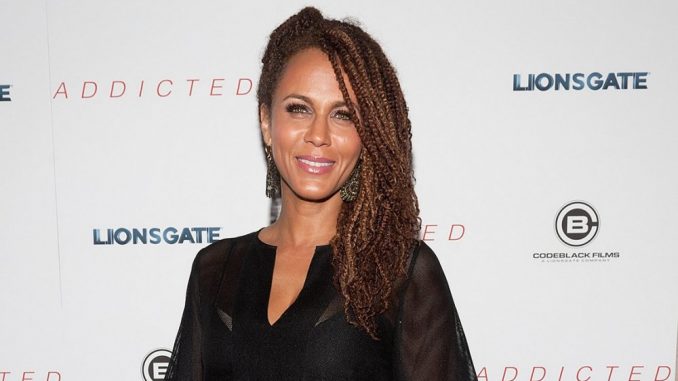

– via www.aarp.org – Whether you rock relaxed hair or a natural ‘do, your hair regimen may look different than it did when you were in your 20s. By default, your tresses undergo several changes as you age that may be related to diet, hormonal fluctuations or any medications you take. And as textured hair tends to be drier, these changes, coupled with improper care, can weaken your strands. Here are some tips to ensure your locks are thriving — even after age 50.
1. Strike a good protein-moisture balance
As we get older, our hair follicles begin to shrink. “[This is] due to collagen loss and a slowed growth cycle causing hair thinning and loss,” explains Monica Stevens, an Atlanta-based licensed cosmetologist, content creator and founder of MoKnowsHair Curl Collection. Additionally, the glands in your scalp produce less oil with age. This is why the right protein and moisture balance is necessary to retain your mane’s strength and elasticity. Good to know: Too much moisture can cause limp, mushy hair, whereas too much protein makes the hair brittle, resulting in breakage.
Pro tip: Concentrated protein treatments are only recommended for chemically or heat-damaged hair, and they should always be followed up with a hydrating conditioner to restore moisture levels.

2. Don’t skip the deep conditioner
You can achieve a delicate protein-moisture balance with a weekly deep conditioner. “Deep treatments allow the hair to maintain structural integrity,” Stevens says. Scope out products that contain moisturizing ingredients (like water, aloe vera, shea butter), as well as common proteins (for example, hydrolyzed wheat, hydrolyzed silk, keratin).
To get the most from your deep-conditioning treatment, apply heat with a hooded dryer or heat cap, and let your tresses absorb all the goodness. “Heat opens up the cuticle, allowing the ingredients to penetrate even deeper into the hair and lock in that moisture,” says Mindy Green, a Washington, D.C. area-based licensed cosmetologist and owner of MG Beauty.
Three conditioning treatments to try: MoKnowsHair Curl Restoring Treatment ($12, sallybeauty.com), Mielle Organics Babassu & Mint Deep Conditioner ($14, target.com) and Ouidad Coil Infusion Deep Conditioner ($38, ulta.com)

3. Try low-manipulation hairstyles
Give your hair a break from years of pulling and tugging. Yes, your hair can still look great without the unnecessary tension. According to Stevens, high manipulation involves daily restyling and high-tension hairstyles such as tight extensions or braids, which can run you the risk of developing a type of hair loss known as traction alopecia. Brought on by constant tension on the hair follicles, traction alopecia mostly affects Black women.
Styles to try? “I like Bantu knots and two-strand twists because they’re low maintenance. Or you can just keep it simple and wear a TWA — teeny weeny afro,” Green says.

4. Get smart about color
One of the most requested services at salons? You guessed it — gray coverage. “If you’re 30 percent gray, go with something more gentle, like semipermanent color, because it stains the outside of the hair. But you don’t get the same degree of coverage as you would with more permanent hair color options,” Green says.
For more opaque coverage, demi-permanent color (ammonia-free and mixed with a low-volume developer) is your best bet because it goes into the cuticle and lasts through about 20 to 25 shampoos. If your hair isn’t chemically or structurally damaged, you can use permanent color or even experiment with highlights. But Stevens warns that lifting the hair will make it more susceptible to damage versus making the hair darker. If your hair is relaxed, avoid permanent color, since both are harsh chemical processes.
Pro tip: Your silver mane is like a blank canvas. Since your locks are no longer pigmented, you can get the hue that you desire without using bleach.

5. Lay low on relaxers
As hair ages, harsh chemicals like relaxers should be used with caution. Relaxers are usually touched up every six to eight weeks, or four weeks for shorter hair. This strict maintenance, and the fact that relaxers break the bonds in the hair that create its texture, often results in damage. If this is the case for you, consider taking your relaxer down a notch by trying a mild relaxer, like a texturizer, which only removes some of the curl pattern, Green advises. Also, keep your trims regular and always follow up with a moisturizing shampoo and deep conditioner.
Three shampoo options to try: KeraCare Hydrating Detangling Shampoo ($6, sallybeauty.com), TGIN Moisture Rich Sulfate Free Shampoo ($15, ulta.com) and TIGI Bed Head Moisture Maniac Moisturizing Shampoo ($26, walmart.com)

6. Minimize heat styling
A good rule of thumb? Use as less heat as possible. Green suggests using a lower heat setting on gray hair; however, sometimes gray hair can be more coarse, and lowering the temperature may not give you your desired results. Using heat that’s too high can discolor gray hair, so always use a heat protectant as a buffer.
Three heat protectant options to try: Mizani Heat Screen Hair Protectant Spray ($22, sephora.com), Tresemme Thermal Creations Heat Tamer Spray ($6, target.com) and CHI 44 Iron Guard Thermal Protection Spray ($16, ulta.com)
7. Evaluate your health
Your best hair days stem from a balanced diet and adequate water consumption. If you can’t get enough nutrients from your diet, consider taking a multivitamin supplement, Green says. The medications you take can also affect your hair, including hormone replacement therapy and thyroid and high blood pressure medication, Stevens notes. If you’ve noticed a change in your hair’s texture, thickness or overall appearance, consult with your doctor to identify a possible medical cause.
Anissa Gabbara writes about beauty, health, lifestyle and pop culture. Her work has appeared in Sisters from AARP, Sesi magazine and Maple City Our Town magazine.

Be the first to comment